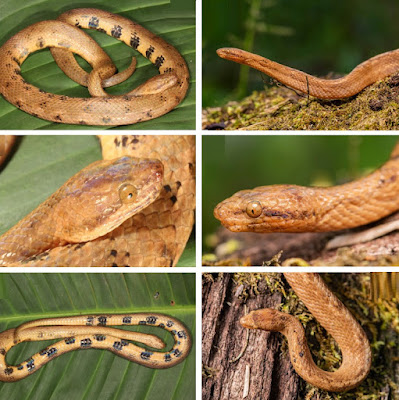[Most Recent Entries] [Calendar View]
Monday, January 2nd, 2023
| Time | Event | ||||
| 8:39a | [Herpetology • 2022] Tropidophis cacuangoae • A Time Relic: A New Species of Dwarf Boa, Tropidophis (Serpentes: Amerophidia: Tropidophiidae), from the Upper Amazon Basin
ABSTRACT The amerophidian snake radiation is a Late Cretaceous superfamily that encompasses two families: Aniliidae, pipe snakes, and Tropidophiidae, dwarf boas. We describe a new dwarf boa snake species, from the Tropidophiidae family, from the cloud forest in northeastern Ecuador. Tropidophis cacuangoae sp. nov. can be diagnosed from its congeners based on external and osteological morphology. The new species inhabits eastern tropical piedmont and lower evergreen montane forests, in the Amazon Tropical Rainforest biome, and is likely to be an Ecuadorian endemic. We also discuss the relationships of the new species with South American tropidophiids and provide a key to the identification of mainland South American dwarf boas. Keywords: taxonomy, osteology, systematics, Serpentes
Tropidophis cacuangoae sp. nov. Diagnosis: Tropidophis cacuangoae sp. nov. can be distinguished from all its congeners based on the following combination of characters: (1) slightly keeled dorsal scales with no apical pits, 23/22/17 or 22/23/17 rows; (2) postoculars three; (3) loreal absent, possibly fused with nasal plate; (4) temporal formula 3 + 4 + 3 or 2 + 3 + 3; (5) supralabials 8–10, with 4th and 5th in contact with eye orbit; (6) infralabials 10–11, with first two pairs in contact with anterior chinshields; (7) ventrals 162 in single male, 156 in single female; (8) subcaudals single, 33 in single male, 30 in single female, male with cloacal spines; (9) in life, dorsal background coloration light brown, with diffuse dorsolateral black blotches, gray vertebral coloration, dark brown postocular stripe and diffuse dark brown pigmentation on labials; (10) in life, ventral background coloration light orange, with large ocellar black blotches, ranging from 16–20, covering up to four ventrals each; (11) maximum SVL 271 mm in single male, and 255 mm in single female; (12) maximum tail length 49 mm in single male, 40 mm in single female; (13) vertebral scale rows 161–162 on body, 32–35 on tail; (14) nasal contacting rostral, first and second supralabials, preocular, anterior prefrontal, and internasal; (15) two pairs of prefrontals; (16) maxillary teeth 18‒21; (17) prefrontal and maxilla bones in contact; (18) dentary and angular bones in contact; (19) medial contact of exoccipitals loose; (20) small ventral ethmoidal foramen in premaxilla body; (21) cervical vertebrae two or less; (22) vomer further expanded laterally to completely encapsulate vomeronasal organ posteriorly; (23) postorbital, dorsomedial head divided in two heads. Etymology: The specific epithet ʻcacuangoaeʼ, is a noun in genitive case, a Latinization honoring Dolores Cacuango, an Ecuadorian benchmark of feminism and human rights of the early twentieth century. She claimed the identity and rights of the Ecuadorian indigenous people, leading them to defend themselves from abuse and discrimination. Also, she demanded the teaching of Quechua and founded the first bilingual schools in Ecuador and the Ecuadorian Indigenous Federation. H. Mauricio Ortega-Andrade, Alexander Bentley, Claudia Koch, Mario H. Yánez-Muñoz and Omar M. Entiauspe-Neto. 2022. A Time Relic: A New Species of Dwarf Boa, Tropidophis Bibron, 1840 (Serpentes: Amerophidia), from the Upper Amazon Basin. European Journal of Taxonomy. 854(1), 1-107. DOI: 10.5852/ejt.2022.854.2021 | ||||
| 1:51p | [PaleoOrnithology • 2022] Confuciusornis shifan • A New confuciusornithid Bird (Confuciusornithidae) with A Secondary Epiphyseal Ossification reveals Phylogenetic Changes in confuciusornithid Flight Mode
Abstract The confuciusornithids are the earliest known beaked birds, and constitute the only species-rich clade of Early Cretaceous pygostylian birds that existed prior to the cladogenesis of Ornithothoraces. Here, we report a new confuciusornithid species from the Lower Cretaceous of western Liaoning, northeastern China. Compared to other confuciusornithids, this new species and the recently reported Yangavis confucii both show evidence of stronger flight capability, although the wings of the two taxa differ from one another in many respects. Our aerodynamic analyses under phylogeny indicate that varying modes of flight adaptation emerged across the diversity of confuciusornithids, and to a lesser degree over the course of their ontogeny, and specifically suggest that both a trend towards improved flight capability and a change in flight strategy occurred in confuciusornithid evolution. The new confuciusornithid differs most saliently from other Mesozoic birds in having an extra cushion-like bone in the first digit of the wing, a highly unusual feature that may have helped to meet the functional demands of flight at a stage when skeletal growth was still incomplete. The new find strikingly exemplifies the morphological, developmental and functional diversity of the first beaked birds. Systematic paleontology Avialae Gauthier, 1986 Pygostylia Chiappe, 2002 Confuciusornithidae Hou et al., 1995 Confuciusornis Hou et al., 1995 Confuciusornis shifan sp. nov. Holotype: PMoL-AB00178, a nearly complete and mostly articulated skeleton, preserved on a single slab Locality and horizon: Xiaotaizi Village, Lamadong Town, Jianchang County, Liaoning Province, China; second unit of Lower Cretaceous Jiufotang Formation (119 Ma). Etymology: The specific name is derived from the Mandarin “shifan”, meaning a paragon of all teachers, in honor of Confucius. The name also commemorates the 70th anniversary of Shenyang Normal University (Shenyang Shifan Daxue). Renfei Wang, Dongyu Hu, Meisheng Zhang, Shiying Wang, Qi Zhao, Corwin Sullivan and Xing Xu. 2022. A New confuciusornithid Bird with A Secondary Epiphyseal Ossification reveals Phylogenetic Changes in confuciusornithid Flight Mode. Communications Biology. 5: 1398. DOI: 10.1038/s42003-022-04316-6 A new specimen illuminates the story of flight evolution in an iconic group of early birds Confuciusornithids only lived in the Early Cretaceous Jehol Biota are indeed a very unusual group of early birds. We are very lucky to encounter Confuciusornis shifan, a new member of this group. |
| << Previous Day |
2023/01/02 [Calendar] |
Next Day >> |





